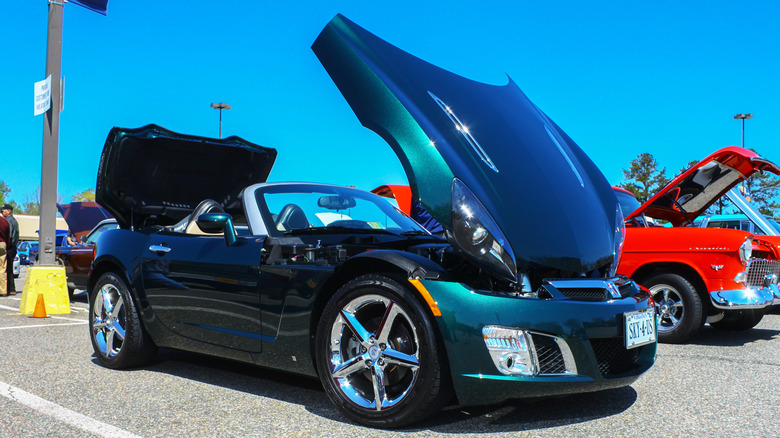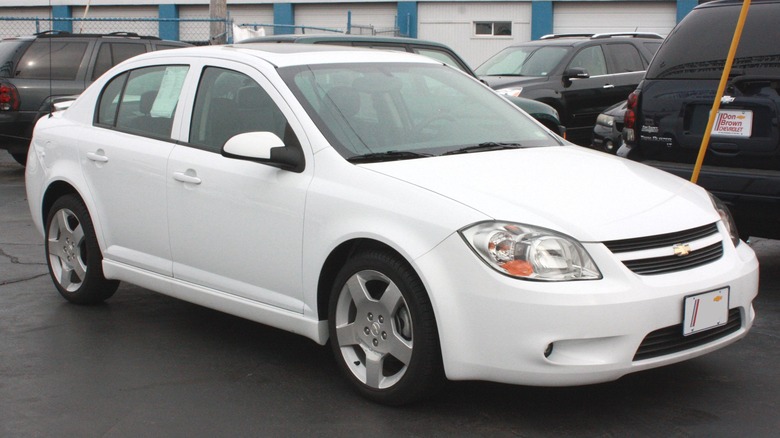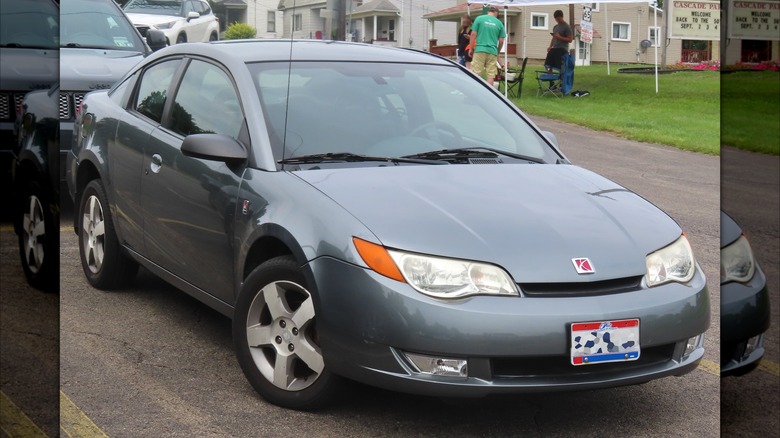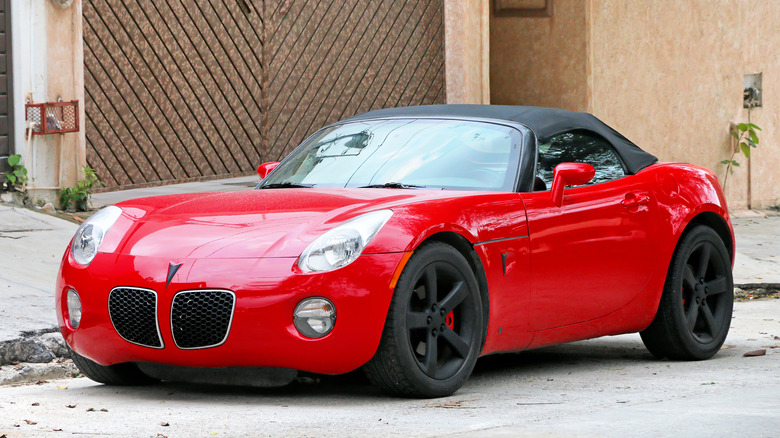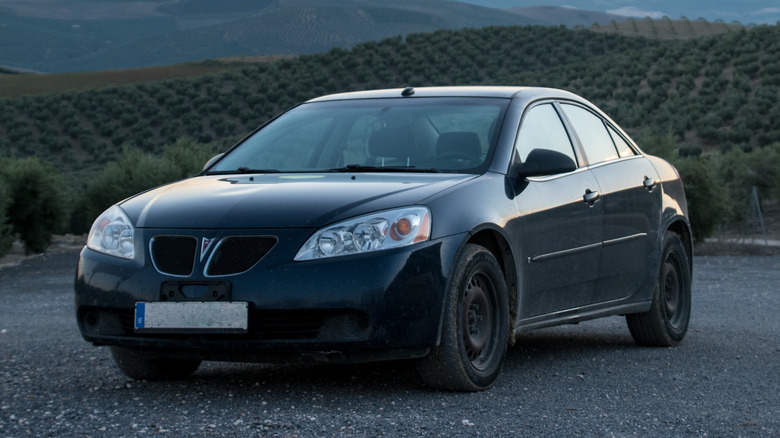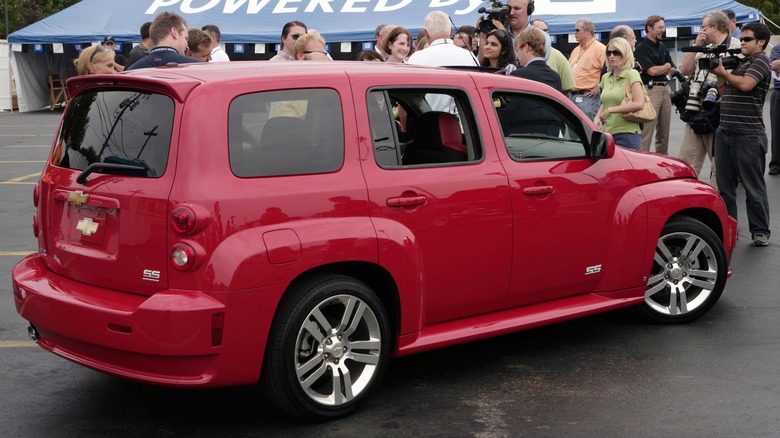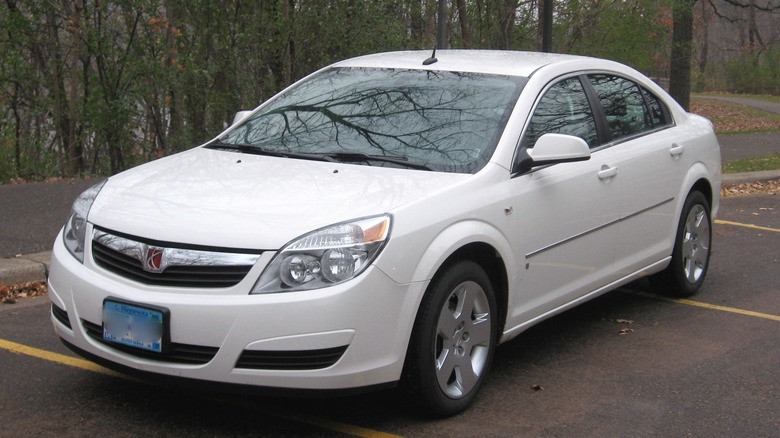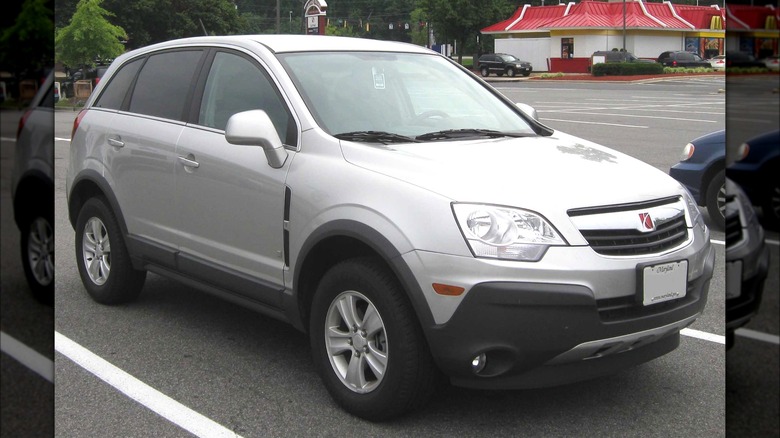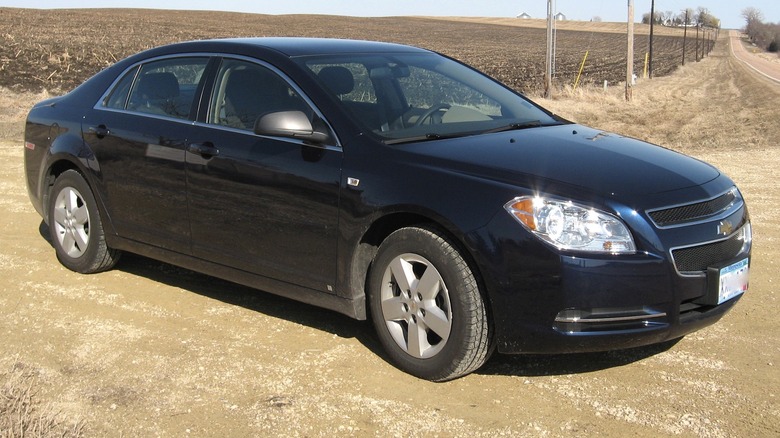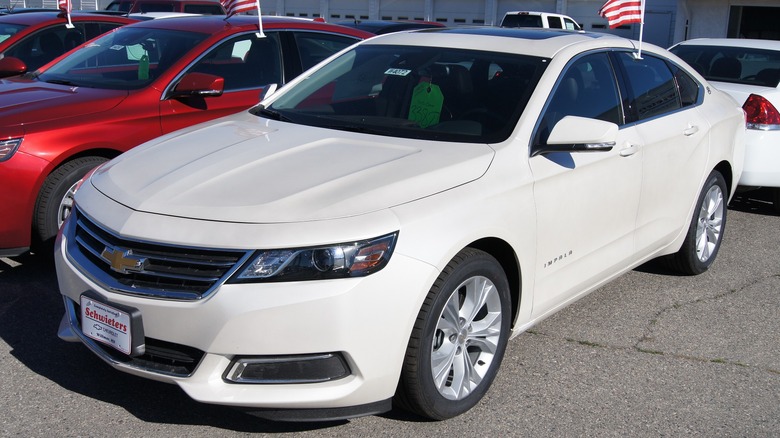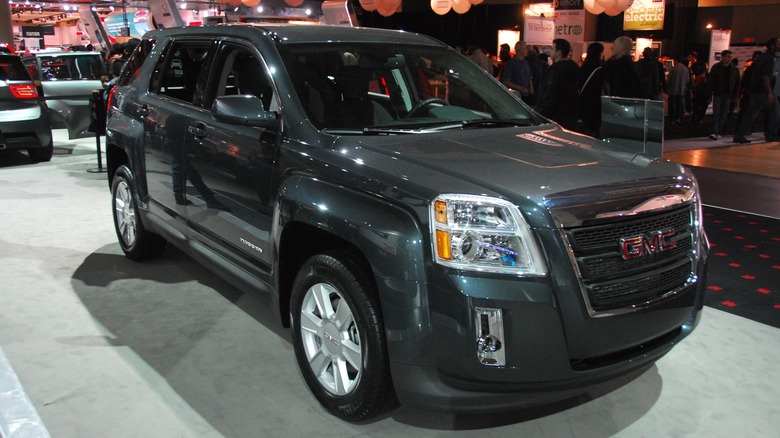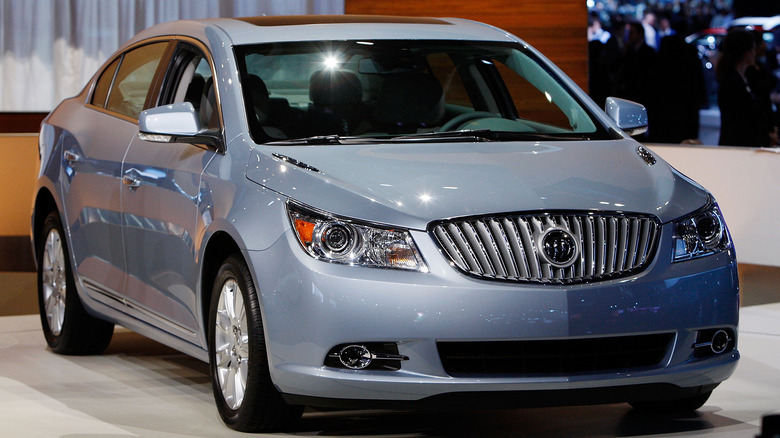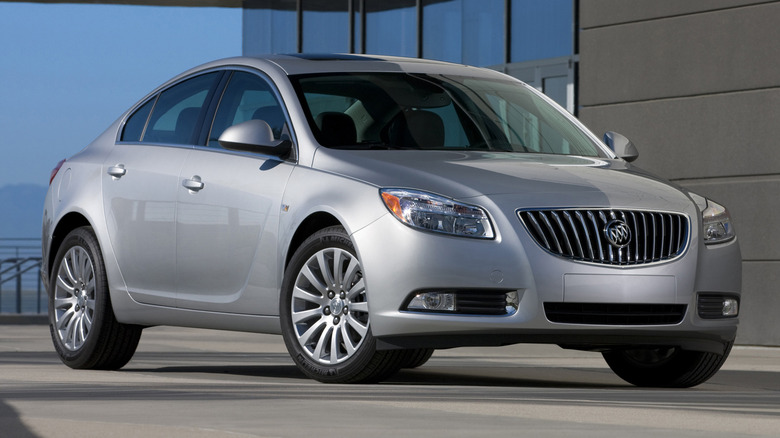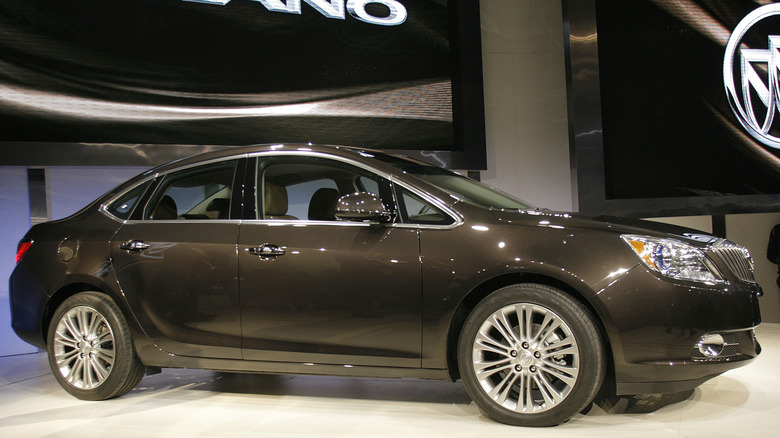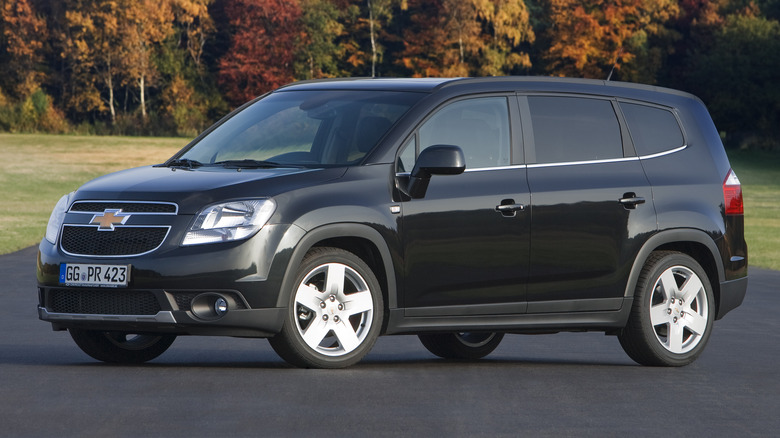Every GM Model Built With The 2.4L Ecotec Engine
General Motors' modern Ecotec engine family first saw the light of day in 2000, when a 2.2-liter inline-four making 147 hp debuted for global use in the Opel Astra — the German brand was a GM subsidiary until it sold it in 2017 — and Saturn's L-series cars. GM updated the 2.2-liter with direct injection a few years later, but it took until 2006 for GM to introduce the 2.4-liter Ecotec engine to cars like the Chevrolet Cobalt and Pontiac G6.
GM engineers based the new 2.4-liter Ecotec on the older 2.2-liter unit, retaining several aspects and features of the smaller engine while adding camshaft phasers — an integral part of any variable valve timing system — and beefing up the construction. The 2.4-liter Ecotec's heyday was from 2006 to 2013, when it featured in several GM vehicle engine bays in various guises — including hybrid, flex-fuel, and direct-injection variants. GM replaced it with a 2.5-liter inline-four engine at the end of that run, but the 2.4-liter hung on for a few more years in cars like the Buick Regal before fully bowing out after 2017.
Let's go through all the GM models that came with the long-lived — and somewhat desirable — four-cylinder engine.
Chevrolet Cobalt and Pontiac G5 (2006 - 2008)
The Chevrolet Cobalt debuted for the 2005 model year after being first unveiled at the end of 2003 at the Greater Los Angeles Auto show. Initially powered by 2.0- and 2.2-liter Ecotec engines, GM quickly introduced the 2.4-liter Ecotec to the Cobalt in 2006 as the sole engine option for the Cobalt SS.
The 2.4-liter Ecotec made 171 hp and 163 lb-ft of torque in the 2006 Cobalt SS. In 2008, Chevrolet renamed the Cobalt's trim levels, and the SS became the Sport coupe and sedan. The Cobalt Sport retained the 171-hp 2.4-liter Ecotec as the standard engine option, but the supercharged 2.0-liter engine was no longer offered as an option. The 2.4-liter Ecotec didn't last much longer, either, and GM ceased offering it in the Cobalt after 2009.
From 2007 to 2009, GM also sold a rebadged Cobalt as the Pontiac G5. The G5, which was also known as the Pursuit — a name that it shared with Pontiac's futuristic Pursuit concept car — featured the same engines as the Cobalt, with the 2.4-liter Ecotec available for the 2007 and 2008 model years.
[Image by Ryanandlenny via Wikimedia Commons | Cropped and scaled | CC BY 3.0]
Saturn Ion (2006 - 2007)
Saturn debuted the Ion at the 2002 New York International Auto Show, showcasing its Quad Coupe concept with dual rear suicide doors alongside a more conventional sedan design. The Ion arrived in dealerships in 2003 with a 2.2-liter Ecotec engine as standard for all trim levels, which would remain the only engine available in the Ion until the 2006 model year.
Saturn introduced the 2.4-liter Ecotec to the Ion 3 trim level — for Quad Coupe and Sedan models — in 2006, with brochures claiming a 170-hp power output from the inline-four. The 2.4-liter engine was only available with the Ion 3's Enhanced Performance Package, which bundled the engine with a sport suspension, anti-lock brakes, and traction control. This meant that prospective owners could get the suspension and anti-lock brakes without the 2.4-liter, but could not have the 2.4-liter without also receiving the handling and braking upgrades.
Sadly, the Ion was not long for this world. The base Ion 1 sedan was already a thing of the past by 2006, and the Ion itself was discontinued in 2007. Saturn itself didn't last much longer either, with poor decisions and a recession consigning the company to an early grave.
[Image by MercurySable99 via Wikimedia Commons | Cropped and scaled | CC BY-SA 4.0]
Pontiac Solstice and Saturn Sky (2006 - 2009)
The Pontiac Solstice and Saturn Sky were twin convertible sports cars from GM, sharing a chassis and foundations, but with notably different styling. The Solstice debuted first, arriving for the 2006 model year with a 177-hp 2.4-liter Ecotec inline-four as the standard engine.
GM added the Solstice GXP to its lineup in 2007, which was a higher-performance version of the Solstice with a turbocharged 2.0-liter Ecotec. 2007 was also the year GM introduced the Saturn Sky, which was available with the same engines as the 2007 Solstice — with the turbocharged 2.0-liter Sky being known as the Sky Red Line. The turbo 2.0-liter also made its way to the Solstice SD-290, an ultra-cool Pontiac concept car, which Pontiac also showcased that year.
GM continued offering the turbo 2.0-liter and naturally aspirated 2.4-liter Ecotec for the rest of the Solstice and Sky's production runs. Both convertibles ceased production in 2009, coinciding with GM's decision to close down the ailing Pontiac brand and sell off Saturn as part of a post-bankruptcy restructuring plan. The latter didn't happen, unfortunately, and Saturn followed Pontiac into the GM graveyard by the end of 2009.
Pontiac G6 (2006 - 2010)
Unlike the G5, the Pontiac G6 was not an overt rebadging of another GM car, although it was based on the Epsilon platform, like the contemporary Chevrolet Malibu. The G6 first broke cover in 2004 and went on sale later that year as a 2005 model-year car with a 300-hp, 3.5-liter V6 under the hood for both trim levels (G6 six-cylinder and GT sedan).
The V6 didn't have the Pontiac G6 engine bay to itself for long, and 2006 saw the brand introduce two new trim levels: G6 and GTP. The G6 came with the 2.4-liter Ecotec inline-four as standard, making a claimed 167 hp, while the GTP — later renamed to GXP for 2008 — came with a 3.9-liter V6 making 240 hp. 2008 also saw Pontiac introduce a 3.6-liter V6, slotting in between the 3.5- and 3.9-liter options.
Pontiac continued building the G6 into early 2010, albeit only as a fleet car. The only engine available for the fleet G6 was the 2.4-liter Ecotec, and one example of such is commonly held as being the last car Pontiac ever built.
Chevrolet HHR (2006 - 2011)
Chevrolet's quirky Chrysler-PT-Cruiser-esque HHR (Heritage High Roof) hit dealerships in 2006 with 2.2- and 2.4-liter Ecotecs available as options. The larger engine made 172 hp and 162 lb-ft of torque and was available as an option in the 1LT trim and came as standard in the highest-tier 2LT trim. Chevrolet quickly added a somewhat strange panel van-style HHR Panel the following year, ditching the rear seats to provide a claimed 63 cubic feet of storage.
The next updates to the HHR came in 2009, when Chevrolet introduced new E85-capable 2.2- and 2.4-liter Ecotec engines as part of GM's efforts to expand its range of flex-fuel cars. A gasoline 2.0-liter inline-four engine was also available in that year's new SS trim, and Chevrolet kept all three engines available into 2010.
Chevrolet dropped the 2.0-liter engine in 2011 and eventually discontinued production of the Mexican-made car entirely that same year.
Saturn Aura (2007 - 2009)
GM unveiled the Saturn Aura in 2006, and it debuted at the start of 2007 with 3.5- and 3.6-liter V6s available in the XE and XR trim levels, respectively. However, it wasn't long before the 2.4-liter Ecotec joined the Aura party: Saturn announced the Aura Green Line hybrid in March 2007, which sported a 2.4-liter Ecotec with belt alternator starter (BAS) hybrid technology and delivered power via a Green Line-specific four-speed automatic transmission.
Saturn introduced a new trim level, the XE I-4, to the Aura in 2008. As the name suggests, the XE I-4 swapped the 3.5-liter V6 of the XE trim for an inline-four engine, namely a non-hybrid 2.4-liter Ecotec producing 164 hp and 159 lb-ft of torque. Saturn revamped the Aura lineup again in 2009, adding another inline-four-powered trim level — XR-4 — to the Aura. Claimed power numbers for XE I-4 and XR-4 Auras climbed slightly to 169 hp and 160 lb-ft of torque, possibly aided by the introduction of a six-speed manumatic transmission.
GM discontinued the Aura in 2009 as it attempted — and failed — to sell the Saturn brand.
[Image by resedabear via Wikimedia Commons | Cropped and scaled | CC BY 2.0]
Saturn Vue and Chevrolet Captiva Sport (2007 - 2013)
Like the Saturn Aura, the 2.4-liter Ecotec was first available in the Vue in BAS hybrid form. The engine made its way to the Saturn Vue Green Line — the company's eco-friendly equivalent to the V6-powered Saturn Vue Red Line — in 2006 for the 2007 model year, making a claimed 170 hp and 160 lb-ft of torque. It was the only 2.4-liter Ecotec available in the SUV until 2008.
GM updated the Vue's base front-wheel-drive trim with the 2.4-liter Ecotec in 2008, replacing the 2.2-liter Ecotec that the Vue debuted with. GM also dropped the five-speed manual transmission option that had been available for the smaller Ecotec in 2007, forcing owners to go with a four-speed automatic if they wanted the 2.4-liter engine. Hybrid and non-hybrid 2.4-liter Ecotecs were available in the SUV until GM shut Saturn down in 2009.
In 2011, GM reintroduced the Vue to the U.S. market as the Chevrolet Captiva Sport. The Captiva was only available as a fleet car and came with an updated direct-injection 2.4-liter Ecotec that made 182 hp. The resurrected SUV didn't last long: Chevrolet stopped building the Captiva Sport for the U.S. market in 2014, though it's still available in Mexico.
Chevrolet Malibu (2008 - 2013)
The seventh-generation Malibu turned heads when it debuted in 2008, gaining favorable comparisons to similarly sized offerings from Honda and Toyota. But the new styling wasn't the only notable feature of GM's new sedan, as it was also the first Malibu to feature the 2.4-liter Ecotec inline-four.
The inline-four engine was available in the LS, 1LT, and 2LT trim levels, with a BAS hybrid version present in the Malibu Hybrid. The standard gasoline Ecotec made 169 hp mated to a four-speed automatic and was available as an engine option throughout the seventh generation. In contrast, the Malibu Hybrid and its BAS Ecotec hybrid only lasted a couple of years and were no longer available by 2010.
Chevy redesigned the Malibu again for the 2013 model year, abandoning the 2.4-liter Ecotec in favor of the new 2.5-liter Ecotec inline-four. However, GM offered a Malibu Eco for the eighth generation, which used a 2.4-liter Ecotec hybrid with eAssist producing 182 hp and 171 lb-ft of torque. The Malibu Eco only lasted a year before GM canceled it in 2014, citing the new 2.5-liter Ecotec's identical fuel efficiency.
[Image by Randy Stern via Wikimedia Commons | Cropped and scaled | CC BY 2.0]
Chevrolet Impala (2014)
General Motors introduced the 10th-generation Impala for the 2014 model year, moving the four-door sedan onto the Epsilon platform, also used for the Cadillac XTS, in an attempt to differentiate it from the Malibu. The new Impala retained the previous generation's 3.6-liter V6 but introduced two Ecotec engines: the 2.5-liter Ecotec and the hybrid 2.4-liter direct injection Ecotec with eAssist, the latter only available in the Impala Eco.
Like the Malibu Eco, the Impala Eco's 2.4-liter engine made 182 hp and 186 lb-ft of torque, with the eAssist system providing an extra 15 hp and 79 lb-ft during acceleration. The combination of an economical four-cylinder engine and GM's eAssist allowed it to claim 29 mpg combined, an improvement over the 25 and 22 mpg for the 2.5-liter Ecotec and 3.6-liter V6, respectively. Not quite enough to make it one of Chevrolet's most fuel-efficient cars ever, but still not bad for 2014.
The Impala Eco was only available for one year, a decision Chevrolet attributed to poor sales. A representative claimed that less than 1% of 2014 Impala buyers opted for the Eco, so it's unsurprising that Chevy decided not to offer it in 2015.
[Image by Greg Gjerdingen via Wikimedia Commons | Cropped and scaled |CC BY 2.0]
Chevrolet Equinox and GMC Terrain (2010 - 2017)
Chevrolet's second-generation Equinox and GMC's first-generation Terrain shared the same platform, and launched for the 2010 model year with new direct-injection versions of GM's 2.4- and 3.0-liter Ecotec engines. Both were among the earliest GM vehicles to come with the new DI Ecotec engines, with the 2.4-liter boasting more power — 182 hp — than the old non-DI 2.4-liter Ecotec, which typically made around 160 hp in GM's vehicles.
GM introduced a flex-fuel version of the 3.0-liter Ecotec V6 in both SUVs in 2011 before bringing E85 support to the base 2.4-liter inline-four engine in 2012. Another engine change came in 2013 when GM replaced the 3.0-liter V6 with a 3.6-liter V6, but the 2.4-liter Ecotec stayed as the standard engine for all trim levels until 2017. GMC explicitly promoted flex-fuel capability for both engines until 2014, after which it stopped mentioning E85 in promotional materials — so it's entirely possible that GM reverted to the non-E85 Ecotec engines from 2015 onward.
As with some of its contemporaries, GM dropped the 2.4-liter Ecotec engine when it refreshed the Equinox and Terrain for 2018. Both SUVs have moved on to bigger and better things, with the 2024 Equinox EV proving particularly impressive during our first drive of the electrified crossover.
[Image by Lord of the Wings© via Wikimedia Commons | Cropped and scaled | CC BY-SA 2.0]
Buick LaCrosse (2011 - 2016)
Buick began selling its second-generation LaCrosse for the 2010 model year after debuting it at the 2009 North American International Auto Show. The car's first year saw 3.0- and 3.6-liter direct-injection V6s in the engine bay for all three trim levels, but Buick quickly replaced the smaller 3.0-liter V6 with the slightly more economical 2.4-liter direct-injection Ecotec in 2011.
Buick claimed 182 hp and 172 lb-ft of torque from the four-cylinder engine, which itself only lasted a year in the LaCrosse. The company swapped it for the eAssist mild hybrid version of the engine in 2012, bringing with it a claimed improvement in fuel economy to 25 city and 35 highway mpg — up from 19 and 30 mpg, respectively, from the non-hybrid Ecotec.
The eAssist Ecotec was available in the LaCrosse until 2016. Buick introduced a redesigned LaCrosse in 2017, with a new 3.6-liter direct-injection V6 as the only engine option. Buick discontinued the LaCrosse in 2019 but reintroduced it for the Chinese market in 2023.
Buick Regal (2011 - 2017)
Buick's Regal was one of the brand's longest-lived nameplates, remaining in production from its 1973 debut until its first discontinuation in 2004. But GM didn't ignore the Regal name for long, introducing a new Opel-based Regal in 2009 for the 2011 model year.
GM chose its direct-injected 2.4-liter Ecotec as the engine for the base CXL trim, where it made 182 hp and 172 lb-ft of torque. There was also a CXL Turbo Regal, which used a direct-injection turbocharged 2.0-liter Ecotec — one of GM's most reliable engines ever. GM updated the Regal's engine options the year after, swapping to an E85-capable 2.4-liter Ecotec and introducing the eAssist hybrid 2.4-liter Ecotec as an option for the non-turbocharged Premium I and Premium II trim levels.
The eAssist 2.4-liter Ecotec replaced the non-hybrid 2.4-liter engine entirely starting in 2013, but GM went back to the direct-injected — and likely non-E85 — 2.4-liter Ecotec for 2016 and 2017 before dropping the 2.4-liter entirely for the redesigned 2018 Regal.
[Image by BUICK REGAL via Wikimedia Commons | Cropped and scaled | CC BY-SA 2.0]
Buick Verano (2012 - 2017)
The Buick Verano, which was based on the Opel Astra, debuted in 2012 as a high-end luxury sedan with an E85-capable 2.4-liter Ecotec inline-four in the engine bay. GM claimed 177 hp and 170 lb-ft of torque from the 2.4-liter engine, and it was the only engine option available in the Verano for the first year of its life.
GM introduced a 250-hp turbocharged 2.0-liter Ecotec in 2013, which buyers could pair with a six-speed manual transmission if desired, but the 2.4-liter Ecotec stayed as the base engine option for the rest of the car's life. There seems to have been some confusion as to whether later model-year 2.4-liter Ecotecs used in the Verano were universally flex-fuel capable, but Buick cleared that up in 2017 when it clearly stated that the Verano was not E85-capable in the owner's manual.
2017 was also the final year of Verano production for the U.S. market, at which point the 2.4-liter Ecotec was the only engine available. The Verano is still alive and well in China, with a third-generation China-only Verano debuting in 2021.
[Image by Michael Gil via Wikimedia Commons | Cropped and scaled | CC BY 2.0]
International models
A few international GM cars also had the 2.4-liter Ecotec engine under the hood for a time. First was the first-generation Chevrolet Orlando, which was sold in Canada, Europe, and Asia. The Orlando — one of many Chevrolet models not available in the U.S. — debuted in Canada for the 2012 model year and ran for only two years, during which the 2.4-liter Ecotec was the only engine option available. The European-market Orlando was not made available with the 2.4-liter inline-four.
GM's China-only Buick GL8 minivan also featured the 2.4-liter Ecotec as one of its engine options across two generations — albeit in a less-than-straightforward manner. GM China began offering the 2.4-liter Ecotec in a refreshed second-generation GL8 for the 2010 model year. However, GM China didn't replace the first-generation GL8 entirely; instead, it revamped the first-generation model slightly and sold it as the GL8 Business Edition, with the 2.4-liter Ecotec as the only engine option.
GM repeated the same trick in 2016, when it launched the third-generation GL8, but the refreshed second-edition GL8 abandoned the 2.4-liter Ecotec in favor of the newer 2.5-liter Ecotec instead.
